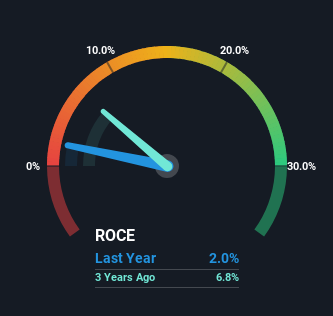
To find a multi-bagger stock, what are the underlying trends we should look for in a business? Typically, we'll want to notice a trend of growing return on capital employed (ROCE) and alongside that, an expanding base of capital employed. This shows us that it's a compounding machine, able to continually reinvest its earnings back into the business and generate higher returns. In light of that, when we looked at Wai Chi Holdings (HKG:1305) and its ROCE trend, we weren't exactly thrilled.
Understanding Return On Capital Employed (ROCE)
If you haven't worked with ROCE before, it measures the 'return' (pre-tax profit) a company generates from capital employed in its business. Analysts use this formula to calculate it for Wai Chi Holdings:
Return on Capital Employed = Earnings Before Interest and Tax (EBIT) ÷ (Total Assets - Current Liabilities)
0.02 = HK$19m ÷ (HK$2.7b - HK$1.7b) (Based on the trailing twelve months to June 2024).
Therefore, Wai Chi Holdings has an ROCE of 2.0%. Ultimately, that's a low return and it under-performs the Semiconductor industry average of 6.1%.
Check out our latest analysis for Wai Chi Holdings

Historical performance is a great place to start when researching a stock so above you can see the gauge for Wai Chi Holdings' ROCE against it's prior returns. If you want to delve into the historical earnings , check out these free graphs detailing revenue and cash flow performance of Wai Chi Holdings.
So How Is Wai Chi Holdings' ROCE Trending?
When we looked at the ROCE trend at Wai Chi Holdings, we didn't gain much confidence. Around five years ago the returns on capital were 6.6%, but since then they've fallen to 2.0%. Although, given both revenue and the amount of assets employed in the business have increased, it could suggest the company is investing in growth, and the extra capital has led to a short-term reduction in ROCE. And if the increased capital generates additional returns, the business, and thus shareholders, will benefit in the long run.
On a side note, Wai Chi Holdings' current liabilities are still rather high at 65% of total assets. This can bring about some risks because the company is basically operating with a rather large reliance on its suppliers or other sorts of short-term creditors. While it's not necessarily a bad thing, it can be beneficial if this ratio is lower.
The Bottom Line On Wai Chi Holdings' ROCE
In summary, despite lower returns in the short term, we're encouraged to see that Wai Chi Holdings is reinvesting for growth and has higher sales as a result. In light of this, the stock has only gained 18% over the last five years. So this stock may still be an appealing investment opportunity, if other fundamentals prove to be sound.
On a separate note, we've found 2 warning signs for Wai Chi Holdings you'll probably want to know about.
While Wai Chi Holdings may not currently earn the highest returns, we've compiled a list of companies that currently earn more than 25% return on equity. Check out this free list here.
Have feedback on this article? Concerned about the content? Get in touch with us directly. Alternatively, email editorial-team (at) simplywallst.com.
This article by Simply Wall St is general in nature. We provide commentary based on historical data and analyst forecasts only using an unbiased methodology and our articles are not intended to be financial advice. It does not constitute a recommendation to buy or sell any stock, and does not take account of your objectives, or your financial situation. We aim to bring you long-term focused analysis driven by fundamental data. Note that our analysis may not factor in the latest price-sensitive company announcements or qualitative material. Simply Wall St has no position in any stocks mentioned.